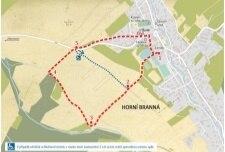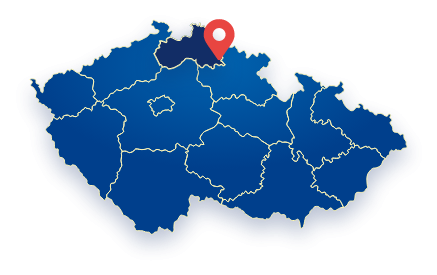Zastavení 3
Tabule – Vodní fauna a flóra
Nacházíme se v parčíku u zámecké cesty, která dále pokračuje do Martinic. Byla vybudována
jako páteřní komunikace harrachovskými lesy. Jdeme po ní od prvního zastavení a tady ji opustíme.
Můžete chvíli posedět, dát si svačinu, pohrát si, nebo zajít přes cestu k Bohdanečskému potoku.
Vody potoků a říček, pokud nejsou znečištěné, brázdí velký počet pstruhů.
Za Harrachů se pstruzi chovali v rybárně v Novém Světě (od r. 1873). Z rybárny se každý rok vypustilo až 100.000 potěru pstruhů do horských vod velkostatku. Rybárna v roce 1934 vyhořela a už nebyla obnovena.
Kromě pstruhů můžeme v podkrkonošských potocích vidět mřenku mramorovanou a střevli potoční.
Z obojživelníků se zde hojně vyskytuje mlok skvrnitý, čolek horský a obecný, ropucha obecná a skokan hnědý. U stojatých vod žije užovka obojková.
Z vodních brouků je nápadný potápník vroubený. Nad podkrkonošskými rybníky létá mnoho druhů vážek a šídel.
Na hladinách rybníků často vídáme kachnu divokou. U potoků a řek lze narazit na skorce vodního, vzácněji i na ledňáčka říčního.
V březnu se na vlhkých lučinách objevuje bledule jarní - posel jara, který často ještě zapadne sněhem. V dubnu jsou břehy vodních toků plny devětsilů. Vlhko má ráda také sasanka narcisokvětá. Ta roste v 1000 m n. m. a výše.
Kraje horských potůčků vroubí oměj šalamounek a stračka vysoká. U potoků roste také všedobr horní, starček potoční. Na lučních prameništích a slatiništích nás upoutají krásné květy orchidejí - vstavačů, prstnatců, pětiprstky žežulníka nebo kruštíka bahenního. Podél potoků roste v rozsáhlých porostech blatouch bahenní
a upolín evropský.
Zámecká cesta
Cesta začíná na nádvoří hornobranského zámku, pokračuje kolem rybníka, přes vrchol Horka a končí u Martinických rybníků. Vede rozsáhlým komplexem lesů mezi Horní Brannou, Martinicemi, Zálesní Lhotou a Jilemnicí.
Byla sjízdná po celý rok a byla vybudována tak, aby po ní mohly jezdit i kočáry. Má povrch z drceného kunčického vápence, takže není bahnitá.
Dnes je ideální zejména pro cyklisty. Ze všech stran je zákaz vjezdu motorových vozidel.
Lesnická naučná stezka U mlejna
Stezka Vás provede oblastí Martinických rybníků a seznámí Vás s minulostí i současností rozsáhlých lesních porostů, které je obklopují.
Trasa naučné stezky, dlouhá 1,9 km, se nachází na pomezí katastrů Martinice, Horní Branná a Jilemnice.
Ke stezce pokračujte dále po Zámecké cestě směrem
na Martinice. Po 2,5 km jste tam.
Station 3
Tafel – Wasserfauna und -flora
Wir befinden uns hier in einem kleinen Park am Schlossweg, der nach Martinice weiterführt. Er wurde als Hauptverkehrsweg durch die Wälder der Harracher angelegt. Wir gehen auf ihm seit der ersten Station und hier verlassen wir ihn. Sie können sich ein Weilchen hinsetzen, ihre Jause bzw. ihr Lunchpaket essen, spielen oder über den Weg zum Bach Bohdanečský potok gehen.
In den Bächen und Flüsschen schwimmt hier, sofern sie nicht verschmutzt sind, ein Vielzahl von Forellen. Unter den Harrachern hegte man Forellen in einer Fischerei in Nový svět (ab 1873). Aus der Fischerei wurden jährlich bis zu 100.000 Forellenlaiche in die Gebirgsgewässer des Großgrundbesitzes gelassen. Die Fischerei brannte 1934 ab und wurde nicht mehr erneuert. Außer Forellen können wir in den Bächen des Riesengebirgsvorlandes auch die Bachschmerle und die Elritze sehen.
Von den Amphibien kommen hier in großer Zahl Feuersalamander, Bergmolche, Teichmolche, Erdkröten und Grasfrösche vor. Bei stehenden Gewässern lebt die Ringelnatter.
Von den Wasserkäfern ist der Gelbrandkäfer auffällig. Über den Teichen des Riesengebirgsvorlandes fliegen viele Arten von Libellen dahin.
Auf den Wasserflächen der Teiche können wir oft Stockenten sehen, an den Bächen und Flüssen Wasseramseln oder – wenn auch seltener – Eisvögel.
Im März zeigt sich auf feuchten Wiesen die Frühlingsknotenblume – Botschafterin des Frühlings, die oft noch von Schnee bedeckt wird. Im April sind die Ufer der Wasserläufe voll von Pestwurzen. Feuchtigkeit mag auch das Narzissen-Windröschen, die in einer Seehöhe von 1000m und höher wächst. Die Ufer der Bergbäche sind vom Hohen Rittersporn und dem Sudeten-Eisenhut gesäumt. An den Bächen wachsen auch der Meisterwurz und das Krause Geiskraut. In Quellgebieten von Wiesen und in Sümpfen ziehen die schönen Blüten von Orchideen unsere Aufmerksamkeit auf sich: Knabenkräuter, der Mücken-Händelwurz oder der Sumpf-Stendelwurz. Entlang der Bäche wachsen in großer Menge die Sumpfdotterblume und die Trollblume.
Der Schlossweg
Der Weg beginnt im Hof des Schlosses Horní Branná, führt weiter – an einem Teich vorbei – über den Berg Horka und endet beim Teich in Martinice. Er führt durch einen ausgedehnten Komplex von Wäldern zwischen Horní Branná, Martinice, Zálesní Lhota und Jilemnice.
Er war das ganze Jahr über befahrbar und so angelegt, dass auch Kutschen auf ihm fahren konnten. Seine Oberfläche besteht aus zerkleinertem Kalk aus Kunčice, ist also nicht schlammig. Heute ist er vor allem für Radfahrer geeignet. Von allen Seiten gilt ein Fahrverbot für motorisierte Fahrzeuge.
Waldlehrpfad „U mlejna“ („Zur Mühle“)
Der Pfad führt Sie durch die Gegend rund um den Teich in Martinice und macht Sie mit der Geschichte und Gegenwart des ausgedehnten Waldbewuchses in der Umgebung bekannt. Die Route des 1,9km langen Lehrpfads befindet sich an den Grenzen der Gemeinden Martinice, Horní Branná und Jilemnice.
Zum Lehrpfad gelangen Sie, wenn Sie auf dem Schlossweg in Richtung Martinice weitergehen. Nach 2,5 km sind Sie dort.
Stand 3
Board – Water fauna and flora
Now we are in the park at the castle path, which goes on up to Martinice. It was built as a backbone road through the forests around Harrachov.
We have been following it since Stand 1 and here we will leave it. Why don’t we sit down for a while, have a snack, play or walk across the path to the Bohdanečský stream.
Waters in streams and rivers, unless they are polluted, are full of trout.
Under the reign of the Harrachs, trout were kept in the fishery in Nový Svět (since 1873). Yearly the fishery released up to 100 000 pieces of trout fry to the mountain waters of the estate. In 1934 the fishery burnt out and was not renewed.
Besides trout we can find the stone loach and common minnow in the streams at the Krkonoše foothills.
Among the amphibians that are quite widely-spread here we can mention e.g. the fire salamander, the alpine newt and the common newt, the common toad and the common frog. Near back-waters the grass snake lives.
A remarkable water beetle species living here is the great diving beetle. Above the Krkonoše Mountains ponds you can see many kinds of dragonflies and damsel-flies. On the surface of the ponds we can often see the mallard. Near streams and rivers we can find the white-throated dipper, and occasionally also the river kingfisher.
In March the spring snowflake – the messenger of spring, which often disappears again under the snow - appears in the wet meadows. In April, the riverbanks are full of butterburs. Also the narcissus anemone likes the wet surroundings. It grows in the altitude of 1000 meters or more. The mountain streams are lined by the garden monkshood and alpine delphinium. Near the streams we can also find the masterwort and the Tephroseris crispa. In the meadow spring areas and moors our attention will be attracted by the beautiful blossoms of orchids – the orchis, the spotted orchid, the fragrant orchid, or the marsh helleborine. Along the streams there are large colonies of the marsh-marigold and globeflower.
Castle path
The path begins in the courtyard and it continues past the pond, across the peak of Horka and it ends at the ponds of Martinice. It goes through the vast forest area among the villages of Horní Branná, Martinice, Zálesní Lhota and Jilemnice.
It was passable all year round and constructed so that even carriages could take it. Thanks to its surface of crushed limestone it is not muddy.
Nowadays it is ideal especially for cyclists. From all sides it is closed for motor vehicles.
Forestry Educational Trail At The Mill (“U mlejna”)
The trail will lead you through the area of Mrtinice ponds and will teach you about the past as well as the present of the vast forests around the trail.
The trail, which is 1.9km long, is located at the border of the cadastres of Martinice, Horní Branná and Jilemnice.
To join the trail, go on along the Castle path towards Martinice. After 2.5km you are there.
Przystanek 3
Tablica – Fauna i flora wodna
Znajdujemy się w parku w pobliżu drogi pałacowej, która ciągnie się do Martinic. Została zbudowana jako trasa osiowa wiodąca przez harrachowskie lasy. Idziemy nią od pierwszego przystanku i tu ją opuszczamy.
Możemy tu chwilę odpocząć, przekąsić coś, pobawić się albo przejść przez drogę do Bohdanečskiego Potoku.
Wody strumieni i rzek, jeśli nie są zanieczyszczone, charakteryzują się dużą liczbą pstrągów. W czasach Harrachów pstrągi hodowano na Nowym Świecie (Nový Svět; od 1873 r.). Co roku w górskie wody wypuszczano z hodowli nawet 100 tys. narybku pstrągów. W 1934 roku hodowla spłonęła i nie była już odbudowana.
Oprócz pstrągów w podkarkonoskich potokach zobaczyć można śliza zwyczajnego i strzeblę potokową.
Z płazów często występuje salamandra plamista, traszka górska i zwyczajna, ropucha szara i żaba trawna. Nad wodami stojącymi żyje zaskroniec.
Z przystosowanych do życia w środowisku wodnym chrząszczy wyróżnia się pływak żółtobrzeżek. Nad stawami lata wiele gatunków ważek. Na powierzchniach stawów często widzimy kaczkę krzyżówkę. Nad potokami natrafić można na pluszcza zwyczajnego, rzadziej też na zimorodka.
W marcu na wilgotnych łąkach pojawia się śnieżyca wiosenna – poseł wiosny, który często zasypywany bywa jeszcze przez śnieg. W kwietniu brzegi rzek i potoków pełne są lepiężników. Wilgoć lubi też zawilec narcyzowaty. Rośnie on na wysokości 1000 metrów n.p.m. i wyżej. Skraje górskich potoczków porasta tojad sudecki i ostróżka wyniosła. Nad potokami rośnie też gorysz miarz i starzec kędzierzawy. Na źródliskowych łąkach i błotach naszą uwagę zwracają piękne kwiaty storczykowatych – storczyków, kukułek, gółki długoostrogowej czy kruszczyka błotnego. Wzdłuż potoków w rozległych zaroślach rośnie knieć błotna i pełnik europejski.
Droga pałacowa
Droga zaczyna się na dziedzińcu pałacu i prowadzi koło stawu przez szczyt Horka, kończąc się nad stawami Martinické Rybníky. Prowadzi przez rozległy kompleks lasów między Horní Branną, Martinicami, Zálesní Lhotą i Jilemnicami.
Przejezdna była przez cały rok. Wybudowano ją tak, żeby mogły po niej jeździć też powozy. Ma nawierzchnię z kruszonego kunčickiego wapienia, nie jest więc błotnista.
Dziś jest idealna, szczególnie dla rowerzystów. Z wszystkich stron obowiązuje zakaz wjazdu dla pojazdów silnikowych.
Leśnicka ścieżka edukacyjna „Koło młyna”
Ścieżka dydaktyczna „U mlejna”, czyli „Koło młyna” oprowadza po okolicach stawów Martinické Rybníky, zapoznając turystów z przeszłością i teraźniejszością rozległych lasów, które ją otaczają.
Mająca 1,9 km trasa biegnie na granicy między miejscowościami Martinice, Horní Branná i Jilemnice.
Do ścieżki należy iść dalej Ścieżką Pałacową w kierunku Martinic. Na miejsce dotrzemy po 2,5 km





